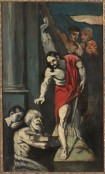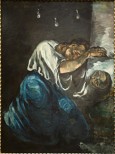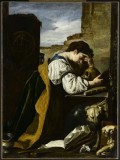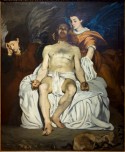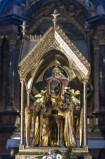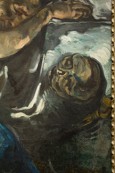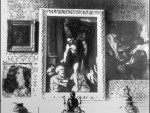The browser will either open the file, download it, or display a dialog.
In 1859, Louis-Auguste Cézanne, father of the painter, acquired the Jas de Bouffan, a villa then on the outskirts of Aix-en-Provence.[1] Paul Cézanne (1839–1906) was given free rein to create a series of frescoes on the walls of the salon; the works date from 1860–70.[2] Two of these large-scale works, Christ in Limbo and Mary Magdalen (Sorrow), now in the Musée d’Orsay, feature religious subjects and are based on old-master precedents that have been well documented by scholars (figs. 1, 2).[3] Despite this research, however, many questions remain with regard to the connection between the two panels, as well as to the mode of representation of Mary Magdalen. The large, weeping figure painted by Cézanne lacks many of the identifying features with which the Magdalen is usually endowed, such as flowing hair, an urn of embalming oil, and feminine beauty, whether in youth or old age. Indeed, when Léonce Bénédite, curator of the Luxembourg Museum, first viewed the salon paintings in situ to evaluate a proposed gift of the suite of paintings to the French state, he described Mary Magdalen as “another figure, also life-size, in an attitude of prayer,” [4] and did not mention the possibility that the painting represented the figure frequently called the “sacred lover of God.”
The style of Mary Magdalen—which was behind Bénédite’s well-known refusal of the work[5]—is one of the most troubling aspects of the painting, even if most scholars have not addressed it. Domenico Feti’s Melancholy (fig. 3), a seventeenth-century painting in the Louvre, has been cited as the principal compositional source.[6] Cézanne’s painting, however, could hardly be more different from the consummate illusionism of Feti’s pensive figure surrounded by attributes of melancholy. Like the Christ in Limbo, it is painted on a dark ground and stands out for its high value contrast, a stylistic feature associated in the 1860s with the art of Edouard Manet. Cézanne’s heavy use of white and blue, in particular in MaryMagdalen, recalls Manet’s Dead Christ with Angels (fig. 4) shown at the Salon of 1864.
Mary Magdalen presents us with a paradox. It is an early painting that renders a serious subject in a style that is difficult to take seriously. In addition, its pairing with the Christ in Limbo remains puzzling. This article will propose an aesthetic for the incommensurability of the painting’s style and subject, and it will present textual evidence from the period to link the motif of the weeping Magdalen with that of Christ in Limbo. Strange as it may sound, the article will argue that a revival of interest in the work of a seventeenth-century Provençal poet can help make sense of the almost burlesque vision of Mary Magdalen that we see in Cézanne’s painting. Building on the work of Nina Athanassoglou-Kallmyer and others, it will also relate the paintings to the Provençal cult of the Magdalen, and in particular, to events from the 1860s that made that cult not only traditional, but current.[7]
As Walter Feilchenfeldt has observed, the poor condition of the Jas de Bouffan at the time of Louis-Auguste Cézanne's acquisition of the property may account for the decision to let the young artist paint the series of murals.[8] Denis Coutagne has noted that the room, with its twelve-foot high ceiling, was used to store fruit prior to the 1859 transfer of the property.[9] The fact that the salon was not a formal sitting room when Cézanne painted the murals helps explain the unconventional nature of the paintings. Although Mary Tompkins Lewis recognizes the experimental nature of the suite, she also suggests that these paintings “were conceived as cohesive decorative schemes appropriate to the noble stature of the Jas de Bouffan” and to the social aspirations of Louis-Auguste Cézanne.[10] The rather rough and uncongenial look of Cézanne’s paintings, however, contradicts Lewis’s conjecture that they were likely meant as decorative objects of status. In addition, the refusal of a proposed gift of the works to the Luxembourg Museum in 1907 (at the moment of a retrospective of Cézanne’s work at the Salon d’Automne) argues against Lewis’s approach. The curator, Bénédite, reasoned that the works would not enhance Cézanne’s growing reputation.[11] I would like to raise the possibility that Cézanne’s strategy lay in a quite opposite direction from that of social ambition: Mary Magdalen and its companions could have been conceived from the start as far from convention, and as emulating a seventeenth-century model that had pushed the boundaries of good taste.
A brief detour into a world of now-obscure early modern poetry will help illuminate this nineteenth-century avant-garde way of thinking. Pierre Larousse’s Grand dictionnaire universel du XIXe siècle—that great repository of received wisdom of the century—offers this entry for “Madeleine,” which it refers to as “the epic poem by the Carmelite, Father Pierre de Saint-Louis (17th century)”:
Should we call this poem epic or burlesque? It is both. It is epic in the intentions of the author, who believed he was creating a work comparable to the Iliad. Despite this, it becomes burlesque in the deviation of its ideas and its images. Its style attains such enormous conceptions, such monstrous proportions, that this "Magdalen" is a curious thing indeed—in its own way compelling as a masterpiece.[12]
This poem—“La Magdeleine au Désert de la Sainte Baume en Provence, Poème spirituel et chrétien,” by Ludovic (Jean-Louis) Barthélemy (1626–77), who would take the name Pierre de Saint-Louis as a Carmelite—contains many features that can be linked with Cézanne’s painting and with the cult of the Magdalen in Provence. In the nineteenth century, the critic and poet Théophile Gautier regarded the poem as a work of art that was both epic and burlesque.[13]
Pierre de Saint-Louis’s poem joins an extensive tradition of seventeenth-century French epic poetry dedicated to Mary Magdalen.[14] Yet the circumstances by which the Carmelite came to write the poem are intimately tied to his monastic orders.[15] Born in Vaureas (now Valréas, north of Avignon) in 1626, and educated in Aix-en-Provence, the young Ludovic Barthélemy was drawn to anagrams and words puzzles as well as poetry and theology. He fell in love with a certain young woman named Magdelaine, whose early death from smallpox precipitated his movement toward the monastery. Once a Carmelite, the stocky, hunchbacked Pierre de Saint-Louis at first gave up poetry as a remnant of worldliness he no longer needed. This would change, however, during a pilgrimage to Sainte-Baume, the grotto east of Mont Sainte-Victoire that was thought to have been the site of Mary Magdalen’s years of penitence, where the monk had a frightening dream.[16] His deceased fiancée appeared to him, and pleaded with him to resume work on a poem dedicated to her patron saint as a way of perpetuating her name. If Pierre de Saint-Louis dedicated himself to the poem, he would return to the graces of Mary Magdalen; if not, he would face death. Pierre de Saint-Louis left the order in which he had been living, and found a niche as a professor of belles-lettres at the Convent of Saint Marcelin, where he completed his poem after five years of work. Published in Lyon in 1668, the poem achieved limited circulation in its first printing.[17] It was anthologized, however, in the 1714 Recueil de pièces choisies tant en prose qu’en vers, a set of volumes that was well represented in major libraries and collections in Paris and in Aix-en-Provence.[18]
In the mid-1830s, the poet and critic Théophile Gautier began to write a series of articles, including one on Pierre de Saint-Louis, which championed a strand of French poetry that had been obscured by the classical aesthetic of Boileau’s influential L’art poétique.[19] Gautier collected these articles under the title Les Grotesques in 1844.[20] At a basic level, Les Grotesques rehabilitates poets who had fallen on the wrong side of a divide that had favored Racine and Corneille over Saint-Amant and François Villon. Further, Gautier explored the very qualities in these works that Boileau’s aesthetic deemed crude and lewd. Les Grotesques was reasonably well received.[21] In the context of the Romantic search for originality and vulnerability of poetic voice, Gautier’s work resonated. Maxime du Camp worried about the possible dimension of irony in the title Les Grotesques: “Only Scalion de Virbluneau and Pierre de Saint-Louis . . . are absolutely grotesque, and worthy of the epithet, which should have been spared to the others,” he wrote in his otherwise laudatory essay.[22] Although Gautier did not set out to make an aesthetic out of tastelessness, he does single out qualities of parody, burlesque, and even poor taste as contributing to the originality of such authors as Cyrano de Bergerac, Georges de Scudéry, and Paul Scarron.[23] In his recent biography of Gautier, Stéphane Guégan considers Gautier’s championing of poor taste as a message specifically aimed at young artists.[24]
Gautier’s article on Pierre de Saint-Louis discusses the Carmelite’s biography, and also proposes an aesthetic that is novel even in the context of an eccentric Romantic excavation of lost works of the past.
I am convinced that it would be impossible for someone to find ten verses as strange as those of Father Pierre de Saint-Louis, for what is detestable for him is never common, never easy; it is an appalling delicacy—knowing, conscientious, admirably supported from one end to the other. There is not a single weak verse in the whole poem.[25]
“It is an appalling delicacy” is Gautier’s paradoxical characterization of a rambling work whose author does not impose a uniform style on its sections. Language games coexist with solemn religiosity in Pierre de Saint-Louis’s hands:
Je publie assez haut la FEMME APOSTOLIQUE,
Et je donne au public une Sainte publique,
Qu’on vit & qu’on oüit hautement publier,
L’histoire qui jamais ne se doit oublier.
Enfin je mets au jour la nouvelle peinture,
DE LA JUIVE, dont l’Art corrigea la Nature,
Un tableau de douleur, un miracle d’amour,
Qui dans un Antre affreux s’alla priver du jour.
La belle MAGDELEINE errante & libertine,
Ayant scandalisé toute la Palestine,
Et de tous ses pechez eu la remission,
Qui vint en ce païs faire sa mission.
HIERUSALEM la vit comme sa Pecheresse,
Et MARSEILLE l’oüit comme sa Prêcheresse;[26]
(Hear, hear, I publicized loud and clear the APOSTOLIC WOMAN, /And I give the public a public Saint, /We saw & we heard, loudly revealed, /The tale that must never be forgotten. /I finally bring to light the new painting, /Of that JEWISH WOMAN, whose Art righted Nature, /A picture of grief, a miracle of love, /Who, in a frightful cave, went to entomb herself, /The beautiful MAGDALEN, wandering & libertine, /Having scandalized all Palestine, /And of all her sins, having had remission, /Who came to this country to carry out her mission. /JERUSALEM saw her as its Sinner, /And MARSEILLE received her as its Priestess;)
If Jerusalem considered Mary Magdalen to be a sinner, she would be received as an evangelist in Marseille; Pierre de Saint-Louis creates puns with the words “public,” “publicize,” and “public woman” (prostitute). The poem’s epic length and alexandrine form are counterbalanced elsewhere in the poem by an insistent playfulness; for instance, by pages of anagrams, such as “Ste. Marie Magdeleine. Anagramme. Ma Rime l’a designée. (My rhyme has named her.)” Even the anthology that disseminated the poem in the early eighteenth century notes that unlike the examples of poetry and prose that are included for their exemplary diction and style, the poem by Pierre de Saint-Louis was reproduced “to amuse the Reader with the ridiculousness of the composition,” as its author “sins against the rules of classical style & of good sense.”[27] The most wide-ranging collection of historical documents pertaining to Mary Magdalen, published in 1848, noted that the poem could only be considered a parody that was suitable for heaping contempt upon Provençal traditions.[28]
Yet to Gautier, the poem’s outrageousness was precisely its strength. “In order to push the bad as far and as convincingly as Pierre de Saint-Louis, you have to be a genius,” wrote Gautier.[29] When Gautier compared the work of Pierre de Saint-Louis with that of Homer, he saw them as dual personifications of poetic intelligence: Homer represented “inspiration,” and Pierre de Saint-Louis was “hot poetic fever,” perhaps best understood as a naiveté valorized by the intensity of its expression.[30] Could a painting also combine a serious religious subject with qualities of burlesque, and if so, what would be its mode of breaking the rules of style (“& of good sense”)? Howard G. Lay has called attention to Arthur Rimbaud’s professed taste for “degraded or otherwise démodé forms of culture”: Rimbaud lists painted shop signs, children’s books, and church Latin; it is a litany which Lay sees as exemplifying a particular nineteenth-century avant-garde strategy.[31] Cézanne was no stranger to parodic forms, especially in his early work, and Nina Athanassoglou-Kallmyer discusses Cézanne’s embrace of humor, especially puns, charades, and rebuses, as something he shares with Provençal culture in general.[32] Athanassoglou-Kallmyer cites many examples of humor in the hybrid forms of Cézanne’s youthful poems, which were not only dotted with rebuses and caricatural drawings, but which also resorted to a mockingly solemn tone for comic effect.[33] Seen against his poetic activity, the burlesque side of Mary Magdalen and the cues he might have taken from Gautier’s Saint-Louis make perfect sense. Cézanne’s figure appears to be the opposite of the conventional Magdalen. In place of flowing hair that recalled the anointment of Christ, Cézanne’s figure’s hair is hardly perceptible against the painting’s dark ground. Light and dark in the painting tend toward extremes, and Cézanne’s drawing of his ungainly figure stands in complete opposition to the academic finesse of which we know he was capable. Pierre de Saint-Louis’s combination of intensity with gaucherie in “La Magdeleine au Désert” could well have been a touchstone for Cézanne; what else was Cézanne’s mode of painting in the 1860s if not “hot poetic fever”?
Mary Magdalen was more, of course, than the subject of Pierre de Saint-Louis’s epic poem and Gautier’s critical attention to it. She was the patron saint of Provence. Even if many in the nineteenth century doubted the legend that she, along with Martha, Lazarus, Maximin, Sidonius, and others, had been sent on a rudderless boat that miraculously sailed from Judea to the southern shores of France, her cult was well established. In 1279, Charles II had succeeded in gaining recognition for relics of Mary Magdalen found at Saint-Maximin in Provence; other relics attributed to Mary Magdalen already belonged to the abbey at Vézelay.[34] Pope Boniface VIII authenticated the relics at Saint-Maximin in 1295.[35] Since that time, numerous defenses have been mounted for the authenticity of the relics, for the cult itself, and for the legend that Mary Magdalen had spent thirty years as a penitent in the Sainte-Baume cave.[36]
The Basilica of Saint-Maximin and the grotto of Sainte-Baume had long been pilgrimage sites.[37] Celto-Ligurian peoples considered the Sainte-Baume forest to be sacred.[38] According to Provençal folklore, a journey of the newly married to La Sainte-Baume would assure a family.[39] The dark and dank grotto itself, which faced northwest, was difficult of access. Its ceaseless dripping of water, said to be an homage to the tears of Mary Magdalen, earned it the name l’Antre Pleureur, the “Crying Cave.”[40] Pierre de Saint-Louis had crafted the line “a Heaven that always rains down, a crying vault” (“un Ciel qui pleut toujours, une pleurante voûte”) in reference to the site of her penitence.
Interest in La Sainte-Baume grew dramatically in the nineteenth century, and peaked as preparations were undertaken for a ceremony to mark the translation of Mary Magdalen’s relics to a new reliquary in 1860. That year marked the bicentenary of the 1660 translation of the relics in the presence of Louis XIV. The new reliquary in gilded bronze (fig. 5) was executed by medieval archaeologist Adolphe-Napoléon Didron (1806–67), his nephew Edouard Didron (1836–1902), and diocesan architect Henri Antoine Révoil (1822–1900); it was based in part on Adolphe-Napoléon Didron’s research into thirteenth-century reliquary designs.[41] Four angels hold aloft the most cherished relic of Saint-Maximin: the skull considered to be Mary Magdalen’s. The arrangement recalls the story in the Golden Legend in which angels carried Mary to heaven seven times a day; there, she received nourishment and heard celestial concerts. Other reliquaries at Saint-Maximin included a sarcophagus, a vial (“la sainte ampoule”) that held stones colored with the blood of Christ carried from the Holy Land by Mary Magdalen, and a reliquary that held a fragment of her arm.[42] Henri-Dominique Lacordaire, the charismatic Dominican preacher from Notre-Dame in Paris, penned a biography of Mary Magdalen in 1860, and the regional newspaper Echo des Bouches-du-Rhône suggested that those who wanted to take part in the ceremony should read it.[43] In addition to calling attention to the radically pure character of Mary’s friendship with Christ, Lacordaire suggested that “one could not set foot on Provençal soil without coming into contact, at each step, with the memory of the Magdalen.”[44] Since Mary Magdalen had touched Christ, her earlier presence in Provence provided a direct link between the region and the physical body of the Savior.
The importance of the ceremony on May 20, 1860 with regard to the religious lives of the faithful in Provence should not be underestimated. The Echo des Bouches-du-Rhône covered the story via short articles about the preparations, and then an extensive “letter to the editor” that described the event somewhat subjectively, but in more detail.[45] Saint-Maximin, about 25 miles east of Aix-en-Provence, had been decorated with garlands and triumphal arches. An important assembly of clergy came together for the occasion, including the archbishop of Aix, bishops from Marseille, Fréjus, Gap, Nîmes, and Nice, and other clergy and civic authorities from the region.[46] After the Dominicans (re-established at Sainte-Baume by Lacordaire) brought in the old reliquary, the seals were broken, and the bishop of Fréjus lifted the venerated skull of Mary Magdalen. It was a moment of high emotion for those present. Lacordaire himself was supposed to have delivered a panegyric, but was not present due to illness; the bishop of Nîmes had to take his place. Although it rained during the early part of the ceremony, once the entire assembly knelt to ask for God’s grace, “the rain ceased, the sun shone radiantly, and the outdoor procession could take place,” at least according to the newspaper’s contributor.[47]
Not only were Provençal traditions related to the cult of Mary Magdalen almost inescapable when Cézanne undertook his painting, but also the events of 1860 were close in both time and place. Cézanne was still living in Aix at the time his archbishop, Georges-Claude-Louis-Pie Chalandon, presided at the ceremony and made the pilgrimage to Sainte-Baume. Attention to the ceremony inspired a wave of poems, in French and Provençal, dedicated to Mary Magdalen.[48] If the events in the region are indeed connected to Cézanne’s painting at the Jas de Bouffan, however, the more interesting question becomes one of how.
Cézanne’s painting rejects many aspects of traditional Magdalen imagery. Unlike many nude or half-nude Magdalens, Cézanne’s figure is clothed in a heavy white chemise and blue skirt. With her bulky shoulders and arms, as well as her large head and rugged features, it is quite possible that her figure had been modeled by a man. She leans forward and rests her hands on a ledge. The setting appears to be that of the grotto of her penitence: there is water in the lower right margin of canvas, and the figure kneels on what is presumably a patch of ground (legend had it that the only dry ground in the grotto was one small mound).[49] Above her, we see three teardrop shapes similar to those embroidered on funeral palls, as Theodore Reff has shown; the tears also recall those of popular devotional imagery, as analyzed by Athanassoglou-Kallmyer.[50] The light tears on a black ground form “a crying vault” pictorially, as they not only frame her figure but also activate what would have been a large expanse of empty space in the upper third of the picture. Cézanne would often use a similar technique in his treatment of wallpaper patterns, for instance, behind still life compositions and in portraits of Madame Cézanne.
Like many an old-master artist who pictured the penitent Magdalen in her cave, Cézanne tries to suggest a dark interior space by showing an opening to the light outside at right. In the very highest part of the light vertical zone on the painting’s right, one can see a patch of blue sky and the green of landscape. These remain quite undefined amid the light scumbling, perhaps because after Cézanne elected to place her hands on the ledge, he could not find a way to resolve the transition between exterior and interior space in the zone below her hands. Below the ledge, we see the skull that traditionally signals the Magdalen’s penitence. As the relic of Mary Magdalen’s skull at Saint-Maximin was the focus of so much discussion in the 1860s, it would seem that Cézanne’s inclusion of the skull represents more than a traditional prop for the meditative figure. Compared with other skulls Cézanne painted in the period, this one appears oddly animated. Areas that denote eye sockets almost look convex; curving brown brushstrokes represent the eye socket in such a way that we almost see the skin of an eyelid, and a black curve looks more like an expressive eyebrow than a bony contour. Cézanne’s representation of the skull here may well be the conceptual opposite of the Saint-Maximin reliquary with its Gothic ciborium form. The Didrons and Révoil’s monument might house the actual cranium of the one touched by the Savior, but it overpowers the relic with its gold, its canopy, and its thirteenth-century style lettering that proclaims “Ora pro nobis.”[51] Cézanne, by contrast, paints the skull with as much vigor as he does the weeping Magdalen herself. In the painting, the skull appears as something organic: it is something almost living and changing under his touch, much the way the relic has a living presence for the believers.
Below the skull sits an object that is difficult to see in reproduction (fig. 6). One can just make out a brown knobby handle and cylindrical form at far right; it angles upward just below the skull. The brownish rod then terminates—again, almost imperceptibly—in wide black strokes that radiate from the handle to the left side, toward the figure. At first glance, the brown form looks as if it could be a bone fragment like the relics kept along with the skull at Saint-Maximin. Once the bristly, black brushstrokes are seen, however, the form suggests one of the instruments of Christ’s flagellation. Although the scourge is far from frequent in images of Mary Magdalen, it does appear, as she had become the patron saint of some flagellant confraternities in earlier centuries.[52] Lacordaire himself was a fervent practitioner of self-mortification and devotional flagellation at the hands of novices, as an important period study of the Dominican elaborates.[53] Thus insofar as the liberal ultramontanist Lacordaire, who died in 1861, was a household name associated not only with the cult of the Magdalen, but also with devotional flagellation, he should be seen a possible reference point for Cézanne’s painting from the end of the 1860s.
Cézanne juxtaposed his painting Mary Magdalen with Christ in Limbo, which he had painted on the wall to the left of the Magdalen image. Mary Tompkins Lewis has indicated the possible connection between the two subjects as “simultaneous events signifying faith and enlightenment.”[54] Although much of the Provençal literature concerned itself with the idea of Mary Magdalen’s years of penitence, we should not overlook the motif of her weeping at the empty tomb of Christ. In fact, a period text stresses the simultaneity of Mary’s tears at the tomb and Christ’s visit to Limbo, prior to the Resurrection. Father Benoît Valuy’s Sainte Marie-Madeleine, published in 1867, goes into great detail about the search for embalming spices and oils by the three Marys, even as they interrupted their attention to the crucified body to observe the Sabbath.[55] He quotes what was considered the authoritative study of Mary Magdalen, that of the medieval Benedictine Rabanus Maurus, who reported that Mary’s tears diluted the aromatic oils, and explained where Jesus had been during her tearful reflections. “His Soul, its Divinity, still the Soul of a God, although separated from the Body, had descended into Limbo.”[56] It is also likely that the evolution of the figure of the penitent Magdalen was intimately linked with the figure in the gospel of St. John, the figure who stands at the sepulchre and weeps before she learns of the Resurrection.[57] Cézanne’s figure may be kneeling in the watery grotto of her years of penitence, but she weeps as she did when she found the stone rolled away from the sepulchre, an event that in Catholic doctrine was simultaneous with Christ’s descent into Limbo.
As the two paintings were originally more than just pendants—they were contiguous images, with Mary Magdalen’s skirt almost overlapping the ground on which Christ walks—it is striking that the figure of Mary Magdalen remains so much larger than that of Christ. A 1912 photograph of the two paintings, still in situ but partially covered by wallpaper and a superficial frame (fig. 7), reveals the effect of the two paintings side by side: the figure of Mary Magdalen may be outsize, but she appears somewhat withdrawn from the viewer in relation to the more dynamic figure of Christ, who seems to stride toward the viewer.[58] Seen in isolation, Cézanne’s Mary Magdalen grapples with the precedent of Manet’s Dead Christ with Angels in its scale and palette, but when Cézanne’s two paintings are seen in their original state, the lean figure of Christ mitigates the visual impact of the penitent female figure. By representing Christ in Limbo, Cézanne alludes to the interval after the Crucifixion and before the Resurrection; in situ, then, Mary Magdalen was more likely to conjure the figure at the tomb. Let us recall that Manet’s 1864 painting, although it represented two angels (one weeping), had invoked the sorrowful Mary Magdalen at Christ’s empty tomb, but had been widely criticized for the liberties Manet had taken with the verses from the Gospel of St. John noted on the inscription in the lower margin of the painting.[59] Taken together, Cézanne’s two scenes propose a more orthodox Catholic reading of the interval between Christ’s Crucifixion and Resurrection than Manet’s painting, even if Cézanne’s painting style was anything but orthodox.
When Cézanne undertook the Jas de Bouffan murals, he was also painting some of his earliest landscapes and portraits, as well as his first paintings of modern life. Portraits presented difficulties that resulted from sitters’ moods and fatigue during the sittings; landscapes presented problems of changing light and weather. Modern-life paintings were even more contingent in character than portraits and landscapes: in their very conception, they called for an engagement with a transitory event, whether a promenade or a murder (to name two of Cézanne’s early subjects).[60] “Modernity oozes with events, whereas traditional societies tended to make events scarce,” writes Pierre Nora: “The authorities and the Church sought to eliminate novelty, to reduce its corrosive power, to swallow it up in ritual.”[61] By choosing a religious and even ritualistic theme, Cézanne would seem to be gravitating toward a subject that offered him the opposite of the contingencies of modern life. Yet for all the qualities of ritual and tradition associated with the subject of the penitent Magdalen, the modern event intrudes in Cézanne’s painting. Amid the signs of timeless legend in the painting, the particularities of the event at St.-Maximin punctuate it: the water of the grotto and the tears of the “Crying Cave” locate the figure in Provence; the scourge connotes Lacordaire and the flagellant Magdalen; the animated skull, no longer merely a memento mori, evokes the ceremonial translation of the relics in 1860.
Cézanne may have set out to take on a conservative subject, but stylistically, his vision of that subject takes it in the direction of the murders and autopsies of his modern-life paintings. Like many of Cézanne’s early works, Mary Magdalen makes use of high value contrast, as light strikes the high planes of the her chiseled face and upper body, which are seen against a black background. Ribbons of white tinged with blues and yellows make up the oversize chemise draped over her hulking frame. Abrupt shifts in value and tone—from light flesh to green, dark gray, and black—characterize the garishly unblended brushstrokes on her face and arm. The bent figure is over life-size. Kneeling, but also deeply bowing her head until her back almost becomes deformed, she closes her eyes and sheds brilliant red tears. Cézanne pushes her massive arms and legs right up to the picture plane, with no represented space for the viewer’s contemplation. Manet’s notorious religious paintings exhibited at the Salons of 1864 and 1865 had featured the body of Christ in theatrical tableaux, and that divine body had appeared all too physical. Cézanne’s figure also confronts the viewer in a very physical way, but Mary Magdalen lacks the theatrical space of beholding that gives dramatic form to Manet’s religious paintings. Like the penitential rite near the beginning of the Mass, her posture confesses her sin; her figure becomes a bodily vision of the Confiteor.[62]
In Provence in the 1860s, Mary Magdalen was patron saint, the friend of the Savior, the sinner whose love and faith elevated her to the status of “the first witness of the resurrection of the Son of God.”[63] The saint represents the union of opposites; she is the profane becoming sacred. There is an intensity of feeling in Cézanne’s painting that draws on the popular cult of the Magdalen as well as high art. Revivals of the poetry of Pierre de Saint-Louis as well as the new reliquary at St.-Maximin, however different from the form of Cézanne’s strange and singular painting, can nevertheless be seen as important reference points. Her legendary thirty years of solitude and penitence can also be seen as a model for the kind of artistic contemplation that Cézanne himself would embrace in the thirty-plus years to come.
The author wishes to acknowledge support from the College of Arts and Architecture at the Pennsylvania State University and from a National Endowment for the Humanities Fellowship, as well as suggestions and support from Robert Alvin Adler, Nina Athanassoglou-Kallmyer, Christopher Campbell, Denis Coutagne, Brian Curran, William Doan, André Dombrowski, Julia Spicher Kasdorf, Pascal Robin, and Jean-Claude Vuillemin. The author also thanks Marissa B. Vigneault for the opportunity to present a portion of this work at the University of Nebraska, Lincoln. Special thanks to Alain Pierret of the Association des Amis de la Basilique Sainte-Marie-Madeleine, Saint-Maximin-la-Sainte-Baume, France.
All translations, unless otherwise noted, are by the author.
[1] Bruno Ely, “‘Pater Omnipotens Aeterne Deus:’ The Purchase and Sale of Jas de Bouffan by the Cézanne Family,” in Jas de Bouffan: Cézanne, ed. Denis Coutagne, trans. A. J. F. Millar (Aix-en-Provence: Société Paul Cézanne, 2004), 25.
[2] According to John Rewald, the other works that have been preserved from the salon—some of which were cut into smaller panels when they were detached from the wall—include: Les Quatre Saisons (four panels, Musée de la Ville de Paris, Petit Palais); Portrait de Louis-Auguste Cézanne, Père de l’artiste (National Gallery, London); Le Baigneur au rocher (Chrysler Art Museum, Norfolk, VA); Le Jeu de cache-cache, après Lancret (Private collection, Japan); Portrait d’Achille Emperaire (Kuneo Fukumoto, Tokyo); Contraste (Ian Woodner Family Collection, New York); two landscape panels that had originally surrounded Le Baigneur au Rocher (whereabouts unknown); and a suite of landscapes taken from Paysage Romantique aux Pêcheurs: Le Donjon (Ryuzaburo Umehara, Tokyo); Ciel entre des arbres and Arbres au bord de la rivière (both in the collection of the late Katia Granoff, Paris); Bord de rivière and Le pêcheur au rocher (France Art Center, Paris); and La Barque, La Pêcheuse, and Le Pêcheur (all three, whereabouts unknown). See John Rewald, in collaboration with Walter Feilchenfeldt and Jayne Warman, The Paintings of Paul Cézanne: A Catalogue Raisonné (New York: Harry N. Abrams, Inc., 1996), 1:67; some collection information is updated in Walter Feilchenfeldt, “Cézanne’s Murals in the Jas de Bouffan,” in Coutagne, Jas de Bouffan, 97.
[3] Lawrence Gowing, Cézanne: The Early Years, exh. cat. (London: Royal Academy of Arts, and Washington, DC: National Gallery of Art, 1988), 12–13 and 136–37, summarizes the literature; for a fuller discussion of the subjects and sources, see Mary Tompkins Lewis, Cézanne’s Early Imagery (Berkeley: University of California Press, 1989), 47–80.
[4] Letter to the Direction des Musées Nationaux, November 1907, RF 1952-10, Department of Documentation, Musée d’Orsay, Paris. A translation of the letter also appears in Rewald, Paintings of Paul Cézanne, 1:67.
[5] Ibid.
[6] Albert Châtelet first suggested the source in Hommage à Cézanne, exh. cat. Musée de l’Orangerie (Paris: Editions des Musées Nationaux, 1954), 5. The artist’s name is spelled “Fetti” here and in some reference works.
[7] Nina Athanassoglou-Kallmyer, Cézanne and Provence: The Painter in his Culture (Chicago: University of Chicago Press, 2003), 68–71.
[8] Feilchenfeldt, “Cézanne’s Murals,” 95. See also Rewald, Paintings of Paul Cézanne, 1:66.
[9] Denis Coutagne, “The Jas de Bouffan,” in Philip Conisbee and Denis Coutagne, Cézanne in Provence, exh. cat. (Washington, DC: National Gallery of Art, and Aix-en-Provence: Musée Granet, 2006), 335n3.
[10] Mary Tompkins Lewis, “Cézanne’s Paintings in the Grand Salon at Jas de Bouffan,” in Coutagne, Jas de Bouffan, 71.
[11] Gerstle Mack discusses Bénédite’s refusal of the works from the Jas de Bouffan; Mack also considers Bénédite’s valuation of the Cézanne paintings in the bequest of Gustave Caillebotte (1894), and the selections of Cézanne’s work at the Salon d’Automne of 1907. See Paul Cézanne (New York: Paragon House, 1989), 143–48, 330–38, 374–75.
[12] Pierre Larousse, Grand dictionnaire universel du XIXe siècle (Paris: Administration du Grand Dictionnaire Universel, s.v. “Madeleine (ou Magdelaine) au désert de La Sainte-Baume, en Provence.”
[13] Théophile Gautier, Les Grotesques, 2nd. ed. (Paris: Michel Lévy Frères, 1856), 125–49.
[14] See Simone de Reyff, Sainte amante de dieu: Anthologie des poèmes héroïques du XVIIe siècle français consacrés à la Madeleine (Fribourg: Editions Universitaires de Fribourg, 1989).
[15] Biographical information in this paragraph can be found in Gautier, Les Grotesques, 127–37. See also Larousse, Grand dictionnaire, s.v. “Pierre de Saint-Louis (le Père).”
[16] Robert Reboul, “L’Homère provençale,” Physionomies provençales (Aix-en-Provence: J. Romardet-Aubin, 1895), 24–25.
[17] Gautier, Les Grotesques, 140.
[18] Bernard de La Monnoye, ed. Recueil de pièces choisies tant en prose qu’en vers, 2 vols. (The Hague: Chez Van-Lom, Pierre Gosse, and Albers, 1714); the poem appears with related material at 2:1–240.
[19] First published in La France littéraire, 3rd. yr. 15, no. 9, September 1834, 5–27.
[20] Stéphane Guégan, Théophile Gautier (Paris: Editions Gallimard, 2011), 81.
[21] See, for instance, Charles-Augustin Sainte-Beuve, Portraits contemporains, rev. ed. (Paris: Michel Lévy Frères, 1874), 5:119–43.
[22] Maxime Du Camp, Théophile Gautier, trans. J. E. Gordon (London: T. Fisher Unwin, 1893), 60.
[23] Gautier, Les Grotesques, xii, 194, 285–86, 335, 338–39.
[24] Guégan, Théophile Gautier, 81–84.
[25] Gautier, Les Grotesques, 143.
[26] As in La Monnoye, Recueil de pièces choisies, 2:27.
[27] Ibid., preface, 1:(n.p.).
[28] Etienne-Michel Faillon, Monuments inédits sur l’apostolat de sainte Marie-Madeleine en Provence, et sur les autres apôtres de cette contrée, saint Lazare, saint Maximin, sainte Marthe et les saintes Maries Jacobins et Salomé (Petit-Montrouge, France: Aux ateliers catholiques, 1848), 1:352.
[29] Gautier, Les Grotesques, 126.
[30] Ibid., 149.
[31] H. G. Lay, “Pictorial Acrobatics,” in Montmartre and the Making of Mass Culture, ed. Gabriel P. Weisberg (New Brunswick, NJ: Rutgers University Press, 2001), 147.
[32] Athanassoglou-Kallmyer, Cézanne and Provence, 55–61.
[33] Ibid., 56.
[34] André Vauchez, La Sainteté en Occident aux derniers siècles du Moyen âge: D’après les procès de canonisation et les documents hagiographiques, rev. ed. (Rome: Ecole Française de Rome; Paris: Diffusion de Boccard, 1988), 266.
[35] Katherine Ludwig Jansen, The Making of the Magdalen: Preaching and Popular Devotion in the Later Middle Ages (Princeton: Princeton University Press, 2000), 318; and Susan Haskins, Mary Magdalen: Myth and Metaphor (New York: Harcourt, Brace and Co., 1993), 131.
[36] See, for instance, Pierre-Joseph de Haitze, Apologétique de la religion des Provençaux, au sujet de Ste Madeleine (Aix: Veuve C. David et J. David, 1711).
[37] Martha Mel Edmunds, “La Sainte-Baume and the Iconography of Mary Magdalene,” Gazette des beaux-arts, 6th per., 114, no. 131 (July-August 1989): 18, notes that it became a pilgrimage site sometime between the late twelfth and the mid-thirteenth centuries.
[38] Edouard Baratier, Histoire de la Provence (Toulouse: Privat, 1969), 38.
[39] W. Branch Johnson, Folktales of Provence (London: 1927; repr. Folcroft, PA: Folcraft Library Editions, 1974), 8–9.
[40] René Alleau, ed. Guide de la Provence mystérieuse (Paris: Tchou, 1965), 414–15.
[41] Didron ainé [Adolphe-Napoléon Didron], Annales archéologiques (Paris: Librairie Archéologique de Victor Didron, 1859), 19:25.
[42] Commission de l’inventaire général des richesses d’art de la France (France), Inventaire général des richesses d’art de la France. Province. Monuments religieux (Paris: E. Plon, Nourrit et Cie, 1901), 3:269.
[43] H.-D. Lacordaire, Sainte Marie-Madeleine [orig. Paris 1860], in Oeuvres du R. P. Henri-Dominique Lacordaire (Paris: Poussielgue, 1880), vol. 9; and Echo des Bouches-du-Rhône, May 13, 1860, 2. Lacordaire had retired from public life in Paris after his condemnation of Napoléon III’s coup d’état, and had become head of a school in Sorèze (Tarn).
[44] Lacordaire, Sainte Marie-Madeleine, 411.
[45] L[ouis] Jourdan, “Fête de Saint-Maximin et de la Sainte-Baume,” Echo des Bouches-du-Rhône, May 27, 1860, 2.
[46] See also Philippe-Ignace André-Vincent, Marie-Madeleine et la Sainte-Baume, 2nd ed. (Paris: Téqui, 1980), 61–63.
[47] Ibid.
[48] See, for instance, Hippolyte Maquan, Sainte Marie-Madeleine: Poème lyrique suivi de notes historiques et archéologiques (Draguignan: Imprimerie de P. Garcin, 1860); andFeuilles mortes de la Sainte-Baume et poussière de la crypte de Ste Magdeleine à Saint-Maximin (Marseille: Imprimerie Saint-Joseph, 1877).
[49] Alleau, Guide de la Provence, 415; see also Lacordaire, Sainte Marie-Madeleine, 425.
[50] Theodore Reff, “Cézanne: The Severed Head and the Skull,” Arts Magazine 58, no. 2 (October 1983): 91; Athanassoglou-Kallmyer, Cézanne and Provence, 68–71.
[51] On the dimensions, lettering, and style of the reliquary, see Arcisse de Caumont, ed., Bulletin monumental, ou Collection de mémoires et de renseignements sur la statistique monumentale de la France, 3rd. ser. 7, no. 27 (Paris: Lance, 1861), 28.
[52] Ruth Wilkins Sullivan, “The anointing in Bethany and Other Affirmations of Christ’s Divinity on Duccio’s Back Predella,” Art Bulletin 67, no. 1 (March 1985): 43.
[53] Bernard Chocarne, Le R. P. H.-D. Lacordaire de l’ordre des Frères Prêcheurs: Sa vie intime et religieuse, 3rd. ed. (Paris: Veuve Poussielgue et fils, 1867), 2:76–85. Reviews of Chocarne’s biography invariably drew attention to Lacordaire’s practices of devotional flagellation.
[54] Lewis, Cézanne’s Early Imagery, 53.
[55] Benoît Valuy, Sainte Marie-Madeleine et les autres amis du Sauveur, apôtres de Provence: Histoire ascétique (Lyon: Imprimerie de C. Jaillet, 1867), 231–37.
[56] Ibid., 241.
[57] John 20:11.
[58] The photograph, from the Corsy Archives, has been reproduced in Coutagne, Jas de Bouffan, 89, and in Rewald, Paintings of Paul Cézanne, 1:122.
[59] Jane Mayo Roos, “Edouard Manet’s ‘Angels at the Tomb of Christ’: A Matter of Interpretation,” Arts Magazine 58, no. 8 (April 1984): 83–91.
[60] See André Dombrowski, “The Emperor’s Last Clothes: Cézanne, Fashion and ‘L’année terrible,’” Burlington Magazine 148, no. 1242 (September 2006): 586–94; and André Dombrowski, Cézanne, Murder, and Modern Life (Berkeley: University of California Press, forthcoming 2012).
[61] Pierre Nora, “The Return of the Event,” in J. Revel and L. Hunt, eds., Histories: French Constructions of the Past, trans. A. Goldhammer (New York: The New Press, 1995), 430.
[62] Pierre Lebrun, Explication de la Messe (Paris: Les Editions du Cerf, 1949), 118: “Le prêtre joint les mains, et se tient dans une posture humiliée, qui convient à l’état du pécheur. Les péchés nous ont courbés vers la terre.” This book, first published between 1716 and 1726, existed in many editions in the nineteenth century, including an 1847 edition in the Bibliothèque Méjanès, Aix-en-Provence.
[63] Lacordaire, Sainte Marie-Madeleine, 422.


